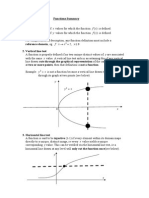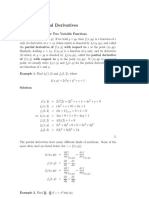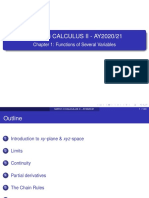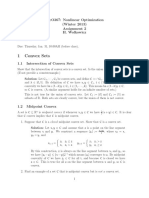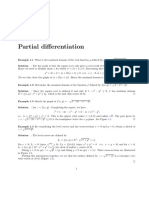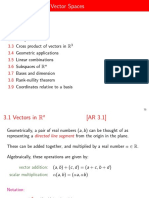9 Multivariable Functions
Uploaded by
slowjams9 Multivariable Functions
Uploaded by
slowjams53
Lecture 9
9.1
Multivariable Functions
Definition of multivariable functions and their natural
domains
Let us first recall that a function of one variable, y = f (x) : D R, is a rule that
assigns a unique real number f (x) to each point x in some set D of the x-axis. The
set D is called the domain of the function. Mostly the domains of the functions we
considered were open or closed intervals, the whole real line R or half-lines.
A function f of two (or three) real variables, x and y (and z, . . . ), is a rule that
assigns a unique number f (x, y) (f (x, y, z)) to each point (x, y) ((x, y, z)) in some
set D of the xy-plane (xyz-space). The set D is also called the domain of the
function.
The above definition extends naturally to functions of n-real variables, usually
denoted by f (x1, x2 , . . . , xn ).
If the domain of the function is not specified, then, as in the single variable case,
it is understood that the domain consists of all points at which the formula in the
definition of the function makes sense; this is called the natural domain of the
function.
The procedure of finding the natural domain is similar to single variable functions. First understand the formula as a chain of operations, as you would if you
1
is represented
computed the formula using the calculator. E.g. f (x, y) =
log(x2 + y)
by the following chain:
x x2 x2 + y log(x2 + y)
1
.
log(x2 + y)
Each step must be well-defined, which gives a number of conditions: no condition for
x2 +y, for log being defined x2 +y > 0, for 1/ log(x2 +y) being defined log x2 + y 6= 0,
i.e. x2 + y 6= 1. In this case the natural domain is given by x2 + y > 0 and x2 + y 6= 1.
The first condition is an inequality. To understand the geometrical shape of the
corresponding domain one may look at the equality x2 + y = 0 first. This is the
parabola y = x2 which cuts the xy-plane into two pieces, one where x2 + y > 0
and x2 + y < 0. To find out which one we are interested in it suffices to check for
one point. Since (1, 0) belongs to the set (12 + 0 > 0), it is clearly the upper part
of the two. From this we need to delete the parabola x2 + y 6= 1, i.e. y 1 = x2 .
The only difference to the analogous problem in single variable calculus is that we
need to handle inequalities and equations that involve several variables and describe
regions in 2 or higher dimensional space.
54
9.2 Graphing multivariable functions
Example 1. Find the natural domain of
(a) f (x, y) = ln(x y 2 )
(b) f (x, y, z) = p
1
1
x2
y2 z2
Solution
(a) For ln(xy 2 ) to be defined, we need xy 2 > 0 and that is the only restriction.
Therefore the natural domain consists of all the points (x, y) which satisfy
x y 2 > 0. We denote
y
this set of points as
{(x, y) : x y 2 > 0}.
Geometrically, this set consists
of all the points lying to the right
of the parabola x = y 2 .
p
(b) For the formula to make sense, we need 1 x2 y 2 z 2 6= 0 and 1 x2
y 2 z 2 0. Combining these two requirements,
z
we need 1 x2 y 2 z 2 > 0, i.e.
x2 + y 2 + z 2 < 1. Thus the natural
domain is {(x, y, z) : x2 + y 2 + z 2 < 1}.
y
This set consists of all the points lying
x
inside the sphere x2 + y 2 + z 2 = 1.
9.2
Graphing multivariable functions
The graph of a function of two variables z = f (x, y) : D R is the surface
{(x, y, z) : (x, y) D, z = f (x, y)}
in the xyz-space lying in a curved way over the domain D.
Another way to visualise functions of 2 variables is the method of level curves.
For a fixed value z = k, the equation f (x, y) = k represents a curve in the xy-space,
called a level curve of height k, or level curve with constant k. These are the
curves of intersection of the graph surface with the planes z = k that are parallel
to the xyplane and intersect the z-axis at the level z = k. Such level curves are
often used in practice, e.g. in meteorology the points of equal barometric pressure
are connected by curves (isobars).
55
9.2 Graphing multivariable functions
The level curves of the ellipsoid x2 + 2y 2 + z 2 = 1 are empty for k < 1 or k > 1
(the planes z = k do not intersect the ellipsoid). For k = 1 the level curves are
just a point (0, 0, 1). For 1 < k < 1 the level curves are the ellipses
x2 + 2y 2 = 1 k 2 .
A three variable function w = f (x, y, z) cannot be realised as a graph in 2
or 3-space. But, similar to level curves, for fixed values w = k, the equations
f (x, y, z) = k represent surfaces in the xyz-space, called a level surfaces of height
k.
Example 2. Describe the graph and level curves for z =
p
1 x2 y 2 .
p
Solution: Square both sides of the equation z = 1 x2 y 2. It results z 2 = 1
x2 y 2 , which is equivalent to x2 + y 2 + z 2 = 1, and we know this equation
p represents
a sphere of radius 1 center (0, 0, 0). However, our initial equation z = 1 x2 y 2
implies that z is always non-negative. Therefore the graph is the upper half of this
sphere, or the upper hemisphere.
p
To describe the level curves, let us choose a constant k and consider 1 x2 y 2 =
k. This equation can hold for some point (x, y) only if 0 k 1, as the left hand
side is p
always between 0 and 1. On the other hand, for each constant k between 0
and 1, 1 x2 y 2 = k is equivalent to 1 x2 y 2 = k 2 , or x2 + y 2 = 1 k 2 . This
last equation represents a circle with center (0, 0) and radius 1 k 2 .
2
z
y
k=0
z=k
y
Example 3. Describe the level surface for w = x2 + (y 1)2 + (z 2)2 .
Solution: Let w = k. Then
x2 + (y 1)2 + (z 2)2 = k
is a sphere of radius
k and center (0, 1, 2) if k 0.
If k < 0, then the equation can never be satisfied.
56
9.3
9.3 Topological properties of domains
Topological properties of domains
For computing limits and derivatives (which are a special type of limits) functions
had to be defined in some neighbourhood of the limit point. On the other hand
for the theorems on extrema and intermediate values of continuous functions it was
essential that the function was defined on a closed interval. To understand the
domain of a multivariable function properly, we need similar notions of open and
closed sets.
If D is a set of points in 2-space, then a point (x0 , y0 ) is called an interior point
of D if there is a circular disk (neighbourhood) with center (x0 , y0 ) and positive
radius which lies entirely in D.
If every such disk contains both points in D
Boundary point
and points not in D, then (x0 , y0 ) is called
Interior point
a boundary point of D. The set of
all interior points of D is called the interior
Interior
of D, and the set of all boundary points
Boundary
of D is called the boundary of D.
In 3-space, the definitions are similar: we replace (x0 , y0 ) by (x0 , y0, z0 ), replace
circular disk by spherical ball.
If a set contains no boundary point, it is called an open set. If a set contains
all its boundary points, it is called a closed set.
The following common terminology is convenient: Any open set containing a
point ~a is called a neighbourhood of ~a. A neighbourhood of ~a from which the
point ~a has been deleted is called a punctured neighbourhood of ~a.
A set S is said to be bounded if it can be put inside some circle or sphere,
otherwise it is unbounded.
A set S is said to be connected if for any two points ~a and ~b of the set there
are finitely many points ~x1 , . . . ~xN such that the segments ~a~x1 , ~x1~x2 , . . . , ~xN 1 ~xN ,
~xN~b are all contained in S.
Example 4.
(a) D1 = {(x, y) : x2 +y 2 2} is a closed set as it contains all its boundary points,
its boundary is the circle x2 + y 2 = 2. It is bounded.
(b) D2 = {(x, y) : x2 + y 2 < 2} is an open set as it contains no boundary point.
The set is bounded.
57
9.3 Topological properties of domains
(c) D3 = {(x, y) : 1 < x2 + y 2 2} is neither open nor closed, as it contains part
of its boundary. It is bounded. (For sketches of the sets D1 , D2 , D3 see the
figure below.)
With boundary
Without boundary
Example 5
(a) D1 = {(x, y) : x2 + y 2 2} consists of all the points lying outside the sphere
x2 + y 2 = 2, including the sphere which is its boundary. It is closed and
unbounded.
(b) D2 = {(x, y) : x2 +y 2 > 2} is D1 without boundary. It is open and unbounded.
(c) D3 = {(x, y) : 1 < x + y 2} consists of all the points lying between the two
lines x + y = 1 and x + y = 2. The line x + y = 2 is in D3 but x + y = 1 is
not. This set is unbounded, but it is neither open, nor closed.
x+y=2
x
x
x+y=1
D1
D2
D3
You might also like
- Exercises: Double and Triple Integrals Solutions Math 13, Spring 2010No ratings yetExercises: Double and Triple Integrals Solutions Math 13, Spring 20108 pages
- Solutions To Tutorial 2 (Week 3) : Lecturers: Daniel Daners and James ParkinsonNo ratings yetSolutions To Tutorial 2 (Week 3) : Lecturers: Daniel Daners and James Parkinson9 pages
- Midterm Exam 2 (MATH 2163 Calculus III Sections 7/9) : S T S S T SNo ratings yetMidterm Exam 2 (MATH 2163 Calculus III Sections 7/9) : S T S S T S4 pages
- E-Note_32257_Content_Document_20250306113128AMNo ratings yetE-Note_32257_Content_Document_20250306113128AM17 pages
- (FREE PDF Sample) Optimization Models Instructor S Solution Manual Solutions 1st Edition Giuseppe C. Calafiore Ebooks100% (9)(FREE PDF Sample) Optimization Models Instructor S Solution Manual Solutions 1st Edition Giuseppe C. Calafiore Ebooks84 pages
- MATH1.3 CALCULUS II - AY2020/21: Chapter 1: Functions of Several VariablesNo ratings yetMATH1.3 CALCULUS II - AY2020/21: Chapter 1: Functions of Several Variables123 pages
- Lecture 2 Calculus of Multi Variables 2011100% (1)Lecture 2 Calculus of Multi Variables 201122 pages
- Lecture 31: Lagrange Multiplier Method: P DF DT T DR DT P P P PNo ratings yetLecture 31: Lagrange Multiplier Method: P DF DT T DR DT P P P P2 pages
- Remark. Happy Holiday, Don't Forget Our Mid-Term Test 1 After HolidayNo ratings yetRemark. Happy Holiday, Don't Forget Our Mid-Term Test 1 After Holiday2 pages
- BRIONES, JOY ANN_WORKBOOK_INDIVIDUAL_RESEARCHNo ratings yetBRIONES, JOY ANN_WORKBOOK_INDIVIDUAL_RESEARCH9 pages
- Pre-Calculus / Math Notes (Unit 5 of 22)No ratings yetPre-Calculus / Math Notes (Unit 5 of 22)11 pages
- Chapter 13 PARTIAL DERIVATIVES Pertemuan 1 Dan 2 6 April 2020 PDFNo ratings yetChapter 13 PARTIAL DERIVATIVES Pertemuan 1 Dan 2 6 April 2020 PDF107 pages
- Function and Application: Mathematics in The Modern World100% (1)Function and Application: Mathematics in The Modern World13 pages
- 1 Convex Sets: C&O367: Nonlinear Optimization (Winter 2013) Assignment 2 H. WolkowiczNo ratings yet1 Convex Sets: C&O367: Nonlinear Optimization (Winter 2013) Assignment 2 H. Wolkowicz4 pages
- Solutions To Tutorial 2 (Week 3) : Lecturers: Daniel Daners and James ParkinsonNo ratings yetSolutions To Tutorial 2 (Week 3) : Lecturers: Daniel Daners and James Parkinson10 pages
- MH1811 Tutorial 1 - MC - 2020 - FN - Lmts - SolnNo ratings yetMH1811 Tutorial 1 - MC - 2020 - FN - Lmts - Soln11 pages
- MAS 201 Spring 2021 (CD) Differential Equations and ApplicationsNo ratings yetMAS 201 Spring 2021 (CD) Differential Equations and Applications23 pages
- Mathematics 1St First Order Linear Differential Equations 2Nd Second Order Linear Differential Equations Laplace Fourier Bessel MathematicsFrom EverandMathematics 1St First Order Linear Differential Equations 2Nd Second Order Linear Differential Equations Laplace Fourier Bessel MathematicsNo ratings yet
- 6-Integration of Vector-Valued Functions, Arc LengthNo ratings yet6-Integration of Vector-Valued Functions, Arc Length5 pages
- Exercises: Double and Triple Integrals Solutions Math 13, Spring 2010Exercises: Double and Triple Integrals Solutions Math 13, Spring 2010
- Solutions To Tutorial 2 (Week 3) : Lecturers: Daniel Daners and James ParkinsonSolutions To Tutorial 2 (Week 3) : Lecturers: Daniel Daners and James Parkinson
- Midterm Exam 2 (MATH 2163 Calculus III Sections 7/9) : S T S S T SMidterm Exam 2 (MATH 2163 Calculus III Sections 7/9) : S T S S T S
- (FREE PDF Sample) Optimization Models Instructor S Solution Manual Solutions 1st Edition Giuseppe C. Calafiore Ebooks(FREE PDF Sample) Optimization Models Instructor S Solution Manual Solutions 1st Edition Giuseppe C. Calafiore Ebooks
- MATH1.3 CALCULUS II - AY2020/21: Chapter 1: Functions of Several VariablesMATH1.3 CALCULUS II - AY2020/21: Chapter 1: Functions of Several Variables
- Lecture 31: Lagrange Multiplier Method: P DF DT T DR DT P P P PLecture 31: Lagrange Multiplier Method: P DF DT T DR DT P P P P
- Remark. Happy Holiday, Don't Forget Our Mid-Term Test 1 After HolidayRemark. Happy Holiday, Don't Forget Our Mid-Term Test 1 After Holiday
- Chapter 13 PARTIAL DERIVATIVES Pertemuan 1 Dan 2 6 April 2020 PDFChapter 13 PARTIAL DERIVATIVES Pertemuan 1 Dan 2 6 April 2020 PDF
- Function and Application: Mathematics in The Modern WorldFunction and Application: Mathematics in The Modern World
- 1 Convex Sets: C&O367: Nonlinear Optimization (Winter 2013) Assignment 2 H. Wolkowicz1 Convex Sets: C&O367: Nonlinear Optimization (Winter 2013) Assignment 2 H. Wolkowicz
- Solutions To Tutorial 2 (Week 3) : Lecturers: Daniel Daners and James ParkinsonSolutions To Tutorial 2 (Week 3) : Lecturers: Daniel Daners and James Parkinson
- MAS 201 Spring 2021 (CD) Differential Equations and ApplicationsMAS 201 Spring 2021 (CD) Differential Equations and Applications
- Transformation of Axes (Geometry) Mathematics Question BankFrom EverandTransformation of Axes (Geometry) Mathematics Question Bank
- Mathematics 1St First Order Linear Differential Equations 2Nd Second Order Linear Differential Equations Laplace Fourier Bessel MathematicsFrom EverandMathematics 1St First Order Linear Differential Equations 2Nd Second Order Linear Differential Equations Laplace Fourier Bessel Mathematics
- 6-Integration of Vector-Valued Functions, Arc Length6-Integration of Vector-Valued Functions, Arc Length
